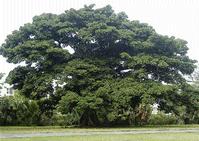
A tree which was trimmed during critical growth periods will maintain a stable centre of gravity. - Ian Allen/Staff Photographer
Did trees fall on your roof during the last hurricane that blew in? We are well into this year's season and the advice from experts is that you should trim them.
By trimming your trees as they grow, you can make them strong enough to resist even hurricane force winds, preventing damage to property and loss of life in the process. A tree which was trimmed during critical growth periods will maintain a stable centre of gravity. Even in mature trees, wind and previous losses of a major limb can create situations where the tree's centre of gravity is not positioned over the trunk. Then when a severe storm hits, a slight bit of extra weight or wind pressure can break limbs, snap the trunk off, or even topple the tree, roots and all.
One can help reposition a tree's centre of gravity by selectively removing branches on the leaning side and encouraging branches on the opposite side. Remove rubbing branches, suckers, watersprouts, and temporary branches.
Note as well that branches that rub against each other produce wounds and decay. One of the offending branches should be removed.
Watersprouts and suckers
Watersprouts and suckers can occur at the base of the tree or inside the crown. They are rapidly growing, weakly attached, and upright branches that do not follow the tree's normal growth pattern. On trees that have been severely damaged, these kinds of branches may be temporarily needed to provide foliage. In healthy trees, however, they most often use more energy than they return to the tree, and it is best to remove them as soon as possible
Often people have the mistaken idea that long natural limbs on a tree will break more easily in a storm, and should be cut back to make them stronger. Just the opposite is the case. When a branch is cut back to a stub, new branches will grow from the edges of the stub. Because they cannot form a strong union with the stubbed branch, these new branches are even more likely to be broken in a future storm.
Throughout the life of a tree, the most influential period for trimming is when the tree is young. A general recommendation is to trim every one to three years for the first 10 to 15 years. During this time, a knowledgeable trimmer will make specific corrections to the branching habits in order to avoid future problems and achieve an intended form. The following are some tips or advice for trimming at this time.
When making your final cut on each branch, make it on the outside edge of the branch collar. Cutting too close to the parent stem is flush cutting. Cutting too far away is stub cutting. Both of these cuts are detrimental to tree health.
The branch collar
The branch collar contains natural tree defence chemicals which protect the tree. If it is removed, the amount of tree decay is increased at the site and the structural integrity of the tree is decreased. If stubs are left, proper closure is hampered and food and shelter source is left for potentially harmful insects or decay fungi.
As trees age, the recommended amount of live wood trimming decreases. Mature and over mature trees generally do not have as much stored energy reserves to counteract the effects of trimming. Live wood, which is necessary for photosynthesis production, is more important to retain for the health of trees. Current recommendation for live wood removal on older trees is 0-10 per cent. Tree topping (removing the upper crown) is not an acceptable tree trimming method (unless the upper portion is deadwood or declining). It adversely affects the health and longevity of trees. It causes a profusion of weakly-attached branches at the top. This does not make trees safer. It destroys the natural form.
Information spruces: http://www.ci.edina.mn.us/Pages/L4-35_TreeTrimming.htm and http://www.arborday.org/media/stormsectionf.cfm.

